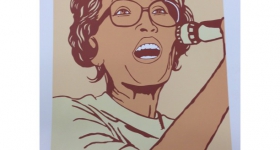As Latinos and Asians race each other to become the fastest growing ethnic population in the United States, the media increasingly sensationalizes differences between both groups. Headlines warn of incipient conflicts on key issues such as immigration and affirmative action. Both groups are resoundingly pitted each other.
In such coverage, history is all but forgotten and little is said about the longstanding political collaborations that have been forged together by both groups in the past. Below are a few key examples. For Latino USA's audio version, click here.
1903-1965: Farm Labor Movements
Latino Americans and Asian Americans have perhaps fought together the longest and hardest through farm labor activism. From the 1903 beet strike held by Japanese and Mexican workers in Oxnard, to 1917 resistance efforts by Puerto Rican and Asian workers in Hawaiian sugar plantations, to the 1965 Delano Grape Strike by Mexican and Filipino farm workers, mobilization of farm workers has been key in solidifying shared histories between Latinos and Asians in America.
1965 Delano Grape Strike and Boycott

Photo courtesy of LeRoy Chatfield
Grape growers in Delano, California had kept Mexican and Filipino farm workers apart in segregated picking crews in order to have one group break the other's strikes during labor disputes. But on September 16, 1965 Mexican Independence Day, the National Farm Workers Association led by César Chávez decided to join the Filipino-formed Agricultural Workers Organizing Committee led by Larry Itliong on the walkouts and picket lines. The strike that galvanized over 4000 Mexicans and Filipinos was to last for over five years, but ended with success as grape growers finally agreed to union contracts that granted farm workers better wages and working conditions.
1943 Japanese-Mexican Strike in Dayton, Washington
Mexican workers brought into the U.S. by the Bracero program and Japanese American workers allowed by the U.S. government to leave internment camps during WWII to work in Northwest farms united to strike at the Blue Mountain Cannery after the men were banned from entering residential areas following an alleged rape where no formal investigation ever took place. After the strike, the restriction order was voided.
1917 Puerto Ricans and Asians mobilize in Hawaiian Sugar Plantations
Puerto Ricans and Asians fight against segregation and unfair working and living conditions.
1903 Oxnard Beet Strike by Japanese and Mexicans
Over 1,200 Japanese and Mexican workers formed the Japanese-Mexican Labor Association (JMLA) to mobilize against the monopoly of contractors that resulted in grossly unfair wages and living conditions.
1968-1969: Third World Liberation Front Student-Led Strikes in San Francisco State University and the University of California, Berkeley

Student groups in San Francisco State University and UC Berkeley held strikes in solidarity to counteract the eurocentric focus in education that overlooks the histories and cultures of Asian Americans, Chicano Americans, African Americans and Native Americans. Strikers picketed, disseminated informational materials, blocked campus entrances, and held classroom walkouts, mass rallies, and teach-ins. Their tactics were met with state force and resulted in much violence as hordes of police were dispatched to arrest students and the California National Guard was called upon to quell the protests. The TWLF movement resulted in the establishment of the first Ethnic Studies departments in the country and increased outreach and enrollment of students of color
1947 Méndez vs. Westminster School District
The LULAC (League of United Latin American Citizens), JACL (Japanese Citizens League), NAACP (National Association for the Advancement of Colored People), and AJC (American Jewish Congress) all filed amicus curiae briefs in support of Gonzalo Méndez, a farmer of Mexican descent whose children were refused enrollment by the "white" school in Orange County, California in 1944. The appellate court upheld the ruling against segregation of schools as incompatible with California law and provided precedent against exclusion of Mexican Americans from public facilities in other states.
1917-1930 Punjabi-Mexican Families Circumvent Alien Land Laws

Photo courtesy of Karen Leonard
In the early 20th century in California's Central and Imperial Valleys, many Punjabi men who migrated to the U.S. for work and were prevented from bringing wives from India by the Asian Exclusion Laws intermarried with Mexican women displaced by the Mexican Revolution. Through their marriage to Mexican women who were legally allowed to own land, Punjabi men, who were barred from land rights by the CA Alien Land Law of 1913, were able to own and plant the peach and prune orchards which today produce 90 percent of the peaches and 60 percent of the prunes that grow in Yuba-Sutter County. Although the 1922 Cable Act would later declare women ineligible for U.S. citizenship and land rights if married to "an alien ineligible for citizenship," intermarriages of around 400 flourished, although exact population statistics are unknown. Former mayor of El Centro, California, David Singh Dhillon, was a third generation Punjabi-Mexican.
2014: Women Factory Workers Mobilize Against Sweatshop Conditions

Photo courtesy of aintiawoman.org
Women factory workers, consisting predominantly of Latina and Asian women workers, are organizing and leading boycotts against sweatshop conditions in factories owned by companies such as the Reynolds Group that provides goods to big box stores like Walmart and Costco. One leading example is the "Ain't I a Woman?!" campaign, a national outreach and educational effort led by woman workers. Demands of the campaign and boycott include: bathroom breaks, sick days, parental leave, an end to forced overtime, the right to speak out and organize without retaliation, and a reinstatement with back pay for those laid off or fired. Sign the petition here: http://aintiawoman.org/petition/
2014: DREAMers and the Undocumented Youth Movement

Photo courtesy of unitedwedream.org
"Undocumented and unfraid!" This is the rallying cry of the DREAMers, undocumented students publicly speaking out against deportation of youth and separation of immigrant families. Latinos and Asian Americans comprise the two largest groups of undocumented minority youth who total to about 2 million. In pan-ethnic collective groups such as the student-led association United We Dream, they tell their real-life stories to change people's minds about immigrants. The speak out despite their fear of being sanctioned and deported. Together, they march, hold sit-ins and hunger strikes, and make thousands of phone calls to senators urging them to pass the DREAM Act. Their efforts have resulted in greater national attention to immigration reform, and to the humanization of undocumented immigrants.
Conclusion:
Rather than emphasize differences between Latinos and Asians in America, we should remember the solidarity demonstrated by both groups throughout American history continuing to today. The process of pan-ethnic solidarity will not always be easy given the diversity and heterogeneity across and among both communities, but we should keep in mind our common problems and goals. Together, we should transform the view of our people as perpetual foreigners in a land we have helped build and enrich. We should fight against the stigmatization of our cultures and discrimination against our people. In continuing to mobilize together, we will spread greater hope and optimism about the future of race relations in the U.S.
Special thanks to Jason Oliver Chang, Assistant Professor of History and Asian American Studies at the University of Connecticut, for sharing his research and advising on this article.










Comments